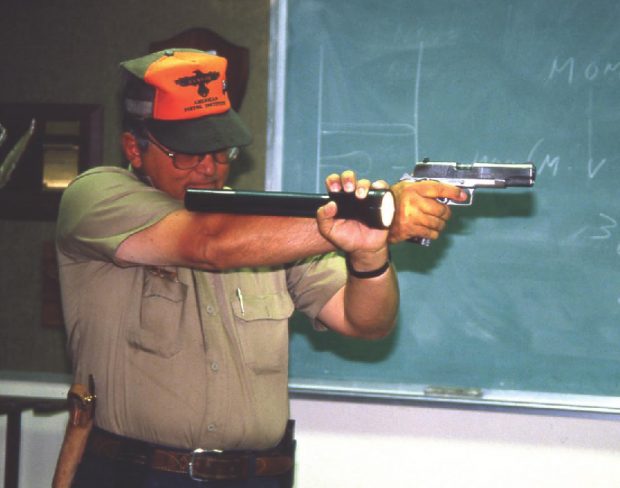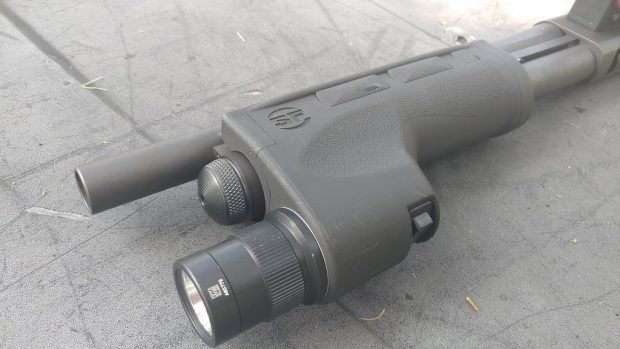Written by: Greg Ellifritz
Earlier this week, I wrote an article covering issues involved in the use of weapon mounted lights. I had a couple readers write me to request some clarification on my position. Here are two examples of the questions they asked me.
“When I’m searching my house, most often, my firearm is at low ready. It is taught and regularly accepted position for searching so you don’t cover someone needlessly. I have a WML with 800 lumens. In total darkness, while searching at low ready, I have plenty of light to search and see. I honestly don’t see the difference? There are times in doorways that I bring the gun back in tight to prevent a grab…then I might be covering someone, but it’s still what I would do without the light. I just don’t see much difference. What am I missing? “
“Great article on WMLs. Do your thoughts change regarding rifles, i.e. search with a depressed muzzle using the corona, not hot spot? “
In my mind, these concerns can be broken down into two distinct questions:
1) Is it OK if I use low (or high) ready with a pistol and “bounce” the light off the floor or ceiling so long as I don’t point the muzzle at what I’m looking for?
2) Is there a difference in tactics between handgun and long gun WML usage?
Let’s take a look at each of those questions separately.
Is it OK to use indirect lighting techniques when searching with a handgun mounted light? I would answer that question as “no.”
We see far more negligent discharges with handgun mounted lights compared to long gun mounted lights. My guess as to why this happens is either the fact that both hands are in very close proximity to each other when using a handgun WML or the fact that some handgun WMLs are actuated by the trigger finger. Under stress, it’s relatively easy to press the trigger when you are trying to turn the light on.
That’s a problem no matter where the muzzle is directed. If using a proper ready position, damage can be minimized if you get on the trigger rather than the light switch. That’s a good thing. But it doesn’t completely relieve you of responsibility. An errant round fired into the floor or ceiling is better than one that is fired into another human, but it is not inconsequential and it may injure either yourself or someone else.
In my mind it’s best to avoid the negligent discharge entirely. When using a handgun with a WML, do your searching with a handheld light. We rarely see negligent discharges of any type when people do this. The one exception is when people are using the “Harries” flashlight technique. Numerous NDs have been reported with this technique. Some folks believe that the close proximity of the two hands when using the Harries light position lead to “hand confusion” and result in negligent discharges.

Harries technique demonstrated by Mike Harries
I only use the Harries position when searching around a right-handed barricade. If you do the same, be extra careful and practice to ensure that you are activating your light and not your pistol’s trigger when you are clearing the corner.
What about when using a long gun weapon mounted light? Is it ever OK to use that system to search?
I would say that it is acceptable to search using a long-gun mounted light, assuming you use a proper low or high ready position and “bounce” the light off of the floor or ceiling for illumination.
As mentioned above, we see fewer negligent discharges from lights mounted on long guns. Almost all are operated by the use of the non-dominant hand rather than the trigger finger. Besides that, there is usually a significant physical separation between the hand operating the light and the hand pulling the trigger. That seems to reduce the chances of a negligent discharge with this system.
In addition to the hand separation issues, we also run into some issues regarding practicality. Have you ever tried to search a building with a long gun and a handheld flashlight? I have. It’s difficult. It’s really hard to both support the weapon and use the flashlight with your non-dominant hand at the same time. This difficulty increases the chances for both a negligent discharge and a miss on a legitimate threat target.
When I’m searching buildings at work, I prefer to use my handgun with a WML used in conjunction with a handheld light. That seems to be the easiest and safest option for me. If I am forced to search a building with a long gun, I use the gun’s weapon mounted light, but I avert the muzzle from the area I am searching.
I hope this clarifies a few things for my readers.

We see fewer issues with long gun lights than handgun lights.

